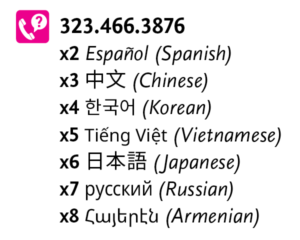Home > About Metro > Rail Modes
Rail Modes
What are the modes of transit operating in LA County?
Light Rail
Metro currently operates light rail transit on the Blue, Green, Gold and Expo Lines. There are currently five rail maintenance and storage facilities to serve these lines. Two projects under construction, Crenshaw/LAX and Regional Connector, will add to this network. Metro is also building the new Southwest Rail Maintenance yard to serve the Crenshaw/LAX Line and support expanded Green Line service.
Characteristics of light rail include:
- Powered by overhead catenary wires
- Typical station spacing: one mile
- Operates above, below or at street level
- Passenger capacity: 135/car
- At peak times, Metro trains:
- Can be up to three cars long
- Carry up to 405 passengers/train
- Operate every five to six minutes
- Top speed 55-65 mph
- Average speed 24-35 mph
Heavy Rail
Metro currently operates heavy rail transit on the Red and Purple Lines. A nine-mile extension of the Purple Line is currently under construction. A rail maintenance and storage facility currently serves these lines. It will be expanded to support the Purple Line Extension.
Characteristics of heavy rail include:
- Powered by third rail
- Typical station spacing: one to two miles
- Only operates above or below ground
- Passenger capacity: 135/car
- At peak times, Metro trains:
- Can be up to six cars long
- Carry up to 810 passengers/train
- Operate every five minutes
- Top speed 70 mph
- Average speed 32 mph
Commuter (or Passenger) Rail
Metrolink operates commuter rail connecting from Los Angeles Union Station to the San Fernando Valley, North County, San Gabriel Valley, Southeast LA County and adjacent counties. Amtrak operates intercity passenger rail service across the United States. In Southern California, their Pacific Surfliner connects between San Luis Obispo and San Diego.
Characteristics of commuter rail include:
- Locomotive-powered
- Typical station spacing: five miles
- Generally operates at ground level
- May share track with freight rail
- May operate above or below ground at selected crossings and via tunnels through mountains
- Fares based on distance traveled
- Specifically scheduled timetables, which can include:
- At peak times, 15- to 30-minute frequencies
- Less frequent service outside of peak times
- Metrolink:
- Passenger seating capacity: 140/car
- Can be up to four to six cars long
- Top speed 79 mph
- Average speed 36 mph
- Amtrak Pacific Surfliner:
- Passenger seating capacity: 70/car
- Can be up to six cars long
- Top speed 79 mph
- Average speed 43 mph
- On-board amenities can include:
- Restrooms
- Water fountains
- Tables for eating, reading or getting work completed
- Power outlets for electronic devices
- Storage space for luggage, bicycles and belongings
- Wi-fi and café car (Amtrak only)
Additional Resources
Contact Us

